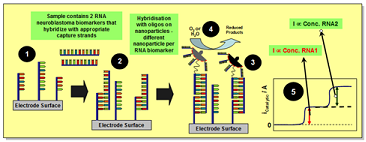Specialized iNANO Lecture: Interfacial Modification: From Disease Biomarkers to Energy
Robert J. Forster, School of Chemical Sciences, Dublin City University, Glasnevin, Dublin, Ireland
Info about event
Time
Location
Teaching room 1593-218, Gustav Wieds Vej 14, 8000 Aarhus C

Robert J. Forster, School of Chemical Sciences, Dublin City University, Glasnevin, Dublin, IrelandInterfacial Modification: From Disease Biomarkers to EnergyThe convergence of interfacial engineering, electrochemistry, materials, and biomedical science at the nanoscale opens up significant opportunities for developing advanced sensors and energy conversion systems. DIAGNOSTICS: For example, successful treatment of disease depends on early detection which can be achieved by quantifying appropriate biomarkers (proteins, antibodies, nucleic acids and cells) that are found at abnormal levels in body fluids or tissue when the disease is present. However, the central challenge is that the concentration of miRNA is typically ultralow, i.e., picomolar or lower. In this contribution, we describe the use of electrocatalytic nanoparticles and ruthenium dyes that generate significant electrochemiluminescence responses even when only a few copies of the miRNA target are present thus avoiding PCR based amplification of the target.
ENERGY: Beyond biomedical diagnostics, ruthenium polypyridine complexes are capable of sensitizing the photooxidation of organic substrates by polyoxometalate under visible irradiation. We have demonstrated that a wide range of organics can be photooxidised using novel POM-Ru complexes provided that there is an abstractable proton even though the oxidation potentials are well in excess of available exciting photonic energy. Here, we report our latest findings on maximising the photocurrents generated using a range of monomeric, polymeric, covalently linked and nanoparticle composite systems.
__________ Host: Associate professor Elena Ferapontova, Interdisciplinary Nanoscience Center, Aarhus University
| |


